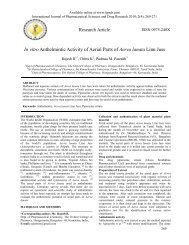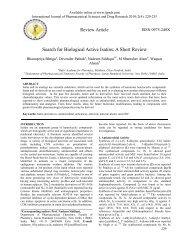Lawsonia inermis Linnaeus - International Journal of ...
Lawsonia inermis Linnaeus - International Journal of ...
Lawsonia inermis Linnaeus - International Journal of ...
Create successful ePaper yourself
Turn your PDF publications into a flip-book with our unique Google optimized e-Paper software.
Chaudhary et al. / <strong>Lawsonia</strong> <strong>inermis</strong> <strong>Linnaeus</strong>: A Phytopharmacological ……………….<br />
and was more clearly mutagenic for strain TA2637. Overall,<br />
the weight <strong>of</strong> evidence suggested that henna and hydroxy<br />
napthaquinone possess no genotoxic risk to the consumer. [47]<br />
Aqueous extract <strong>of</strong> leaves <strong>of</strong> L. <strong>inermis</strong> showed the<br />
significant antibacterial effect against. [48] Aqueous, methanol<br />
and chlor<strong>of</strong>orm crude extracts <strong>of</strong> leaf showed the in-vitro<br />
antimicrobial activity to inhibit the growth <strong>of</strong> 6 human<br />
pathogenic fungi and 4 types <strong>of</strong> bacteria in dose dependent<br />
manner. [49-51]<br />
Antifungal activity<br />
During screening <strong>of</strong> barks <strong>of</strong> 30 plant species against<br />
Microsporum gypseum and Trichophyton mentagrophytes,<br />
only L. <strong>inermis</strong> L. extract exhibited absolute toxicity. The<br />
extract showed broad fungitoxic spectrum when tested<br />
against 13 ring worm fungi. Further the fungitoxicity <strong>of</strong> the<br />
extract remained unaltered at high temperature on<br />
autoclaving and after long storage. [52] The leaves <strong>of</strong> L.<br />
<strong>inermis</strong> L. were also found to exhibit strong fungi toxicity<br />
and non-phytotoxicity. The minimum effective dose against<br />
[53]<br />
test organism was found to be 1000ppm. Ethanol,<br />
methanol and aqueous extract <strong>of</strong> leaves <strong>of</strong> L. <strong>inermis</strong> are<br />
involved in defensive mechanism against spore germination<br />
<strong>of</strong> Drechslera oryzae.<br />
[54] Lawsone isolated from the leaves<br />
<strong>of</strong> L. <strong>inermis</strong> has shown significant antifungal antibiotic<br />
effect. [55] Aqueous extract <strong>of</strong> leaves <strong>of</strong> L. <strong>inermis</strong> was tested<br />
for the antifungal potential against eight important species <strong>of</strong><br />
Aspergillus which isolated from sorghum, maize and paddy<br />
seed samples. A. flavus recorded high susceptibility and<br />
hence solvent extracts viz., petroleum ether, benzene,<br />
chlor<strong>of</strong>orm, methanol and ethanol extracts <strong>of</strong> the plant<br />
showed significant antifungal activity.<br />
[56] Essential oil<br />
obtained by hydro-distillation from leaves <strong>of</strong> L. <strong>inermis</strong><br />
growing in Iran were analysed by GC-MS and showed an<br />
antifungal activity. [57] Ethanol extract <strong>of</strong> leaves <strong>of</strong> L. <strong>inermis</strong><br />
showed significant antifungal effect against phytopathogenic<br />
fungi. Ethanol extract could be used as alternative source <strong>of</strong><br />
antifungal agents for protection <strong>of</strong> plants or crops against<br />
fungal infection. [58]<br />
Antiviral activity<br />
The ethanol soluble fraction <strong>of</strong> L. <strong>inermis</strong> fruits displayed<br />
highly potent activity against Sembiki forest virus (SFV) in<br />
swiss mice and chick embryo models exhibiting 100 to 65 %<br />
activities after 10 to 25 days <strong>of</strong> virus challenge. [59]<br />
Antitrypanosomal activity<br />
Crude Methanolic extract <strong>of</strong> leaf <strong>of</strong> L. <strong>inermis</strong> showed invitro<br />
activity against Trypanosoma brucei at concentration <strong>of</strong><br />
8.3 mg/ml <strong>of</strong> blood in mice but not in-vivo. The treatment<br />
tends to ameliorate the disease condition, but did not affect<br />
the level <strong>of</strong> parasitaemia and pack cell volume. [60]<br />
Antiparasitic activity<br />
During an ethnopharmacological survey <strong>of</strong> antiparasitic<br />
medicinal plants used in Ivory Coast, 17 plants were<br />
identified and collected. Polar, non-polar and alkaloidal<br />
extracts <strong>of</strong> various parts <strong>of</strong> these species were evaluated invitro<br />
in an antiparasitic drug screening. Antimalarial,<br />
leishmanicidal, trypanocidal, antihelminthiasis and<br />
antiscabies activities were determined. Among the selected<br />
plants, L. <strong>inermis</strong> L. showed interesting trypanocidal<br />
activities. [61]<br />
Molluscicidal activity<br />
L. <strong>inermis</strong> showed significant molluscicidal activity. [62]<br />
Antidermatophytic activity<br />
The antidermatophytic activity <strong>of</strong> ethanol, ethyl acetate and<br />
hexane extracts <strong>of</strong> L. <strong>inermis</strong> were tested on 5 strains each <strong>of</strong><br />
Tinea rubrum and Tinea mentagrophytes. All these extracts<br />
showed significant antidermatophytic properties in-vitro. [63]<br />
Tuberculostatic activity<br />
The tuberculostatic activity <strong>of</strong> henna was tested in-vitro and<br />
in-vivo. On Lowenstein Jensen medium, the growth <strong>of</strong><br />
Tubercle bacilli from sputum and <strong>of</strong> Mycobacterium<br />
tuberculosis H37Rv was inhibited by 6 µg/ml <strong>of</strong> the herb. Invivo<br />
studies on guinea pigs and mice showed that the herb at<br />
a dose <strong>of</strong> 5 mg/kg body weight led to a significant resolution<br />
<strong>of</strong> experimental tuberculosis following infection with<br />
Mycobacterium tuberculosis H37Rv. [64]<br />
Antifertility activity<br />
Ethanol extract prepared from the powdered seeds <strong>of</strong> L.<br />
<strong>inermis</strong> L. failed to show any antifertility activity. However<br />
in subsequent studies it was observed that the powdered<br />
leaves <strong>of</strong> when administered as suspension or incorporated<br />
into the diet inhibited the fertility <strong>of</strong> rats. The fertility<br />
induced appeared to be permanent. [65]<br />
Analgesic activity<br />
The ethanol extract <strong>of</strong> 25 plants commonly used in traditional<br />
Arab system <strong>of</strong> medicine for treatment <strong>of</strong> pain, fever and<br />
rheumatism were investigated for their analgesic and<br />
antipyretic activities. The extract <strong>of</strong> leaves <strong>of</strong> henna showed<br />
significant analgesic as well as antipyretic activity. [66] The<br />
fixed oil obtained from seeds were screened for<br />
pharmacological activity both in-vitro and in-vivo. It was<br />
concluded that seed oil is devoid <strong>of</strong> behavioural and CNS<br />
effects and failed to produce any effect on isolated tissue<br />
though it possess significant analgesic activity. [67]<br />
Anti-inflammatory activity<br />
Isoplumbagin and lawsaritol, isolated from stem bark and<br />
root <strong>of</strong> L. <strong>inermis</strong> L. showed anti- inflammatory activity<br />
against Carrageenan induced paw oedema in rats. The<br />
compounds phenylbutazone, isoplumbagin and lawsaritol at<br />
the oral dose <strong>of</strong> 100 mg/kg exhibited 61, 60 and 40 percent<br />
inhibition in comparison with controls. Isoplumbagin showed<br />
significant anti- inflammatory activity similar to that <strong>of</strong><br />
phenylbutazone.<br />
[68] Butanol and chlor<strong>of</strong>orm fractions<br />
showed more potent anti-inflammatory, analgesic and<br />
antipyretic effects than aqueous fraction <strong>of</strong> crude ethanol<br />
extract <strong>of</strong> L. <strong>inermis</strong> in a dose dependent manner. [69] Leaves<br />
showed significant anti-inflammatory effect with some active<br />
principles. [70-71]<br />
Cytotoxic activity<br />
Isoplumbagin exhibited up to a 1000 fold range <strong>of</strong><br />
differential sensitivity, which represents distinct fingerprint<br />
<strong>of</strong> cellular responsiveness. At concentration <strong>of</strong> 10.5–10.8 M,<br />
the compound typically produced LC50 – level responses<br />
against a majority <strong>of</strong> the melanoma and colon cancer cell<br />
lines as well as against several <strong>of</strong> the non- small cell lungs,<br />
colon, CNS, and renal cell lines. Isoplumbagin showed an<br />
interesting pr<strong>of</strong>ile <strong>of</strong> cytotoxic activity.<br />
[72] Chlor<strong>of</strong>orm<br />
extract <strong>of</strong> leaves <strong>of</strong> L. <strong>inermis</strong> displayed the cytotoxic effects<br />
against liver (HepG2) and Human breast (MCF-7) with IC50<br />
values <strong>of</strong> 0.3 and 24.85µg/ml by microculture tetrazolium<br />
salt assay (MTT). [42] CAT assay, a zone <strong>of</strong> inhibition test <strong>of</strong><br />
bacterial growth and colony-forming efficiency test <strong>of</strong><br />
transformant Escherichia coli strains that express mammalian<br />
catalase gene derived from normal catalase mice (Cs a ) and<br />
catalase-deficient mutant mice (Cs b ), Ames mutagenicity<br />
assay and H2O2 generation assay are carried out.<br />
IJPSDR April-June, 2010, Vol 2, Issue 2 (91-98) 93






